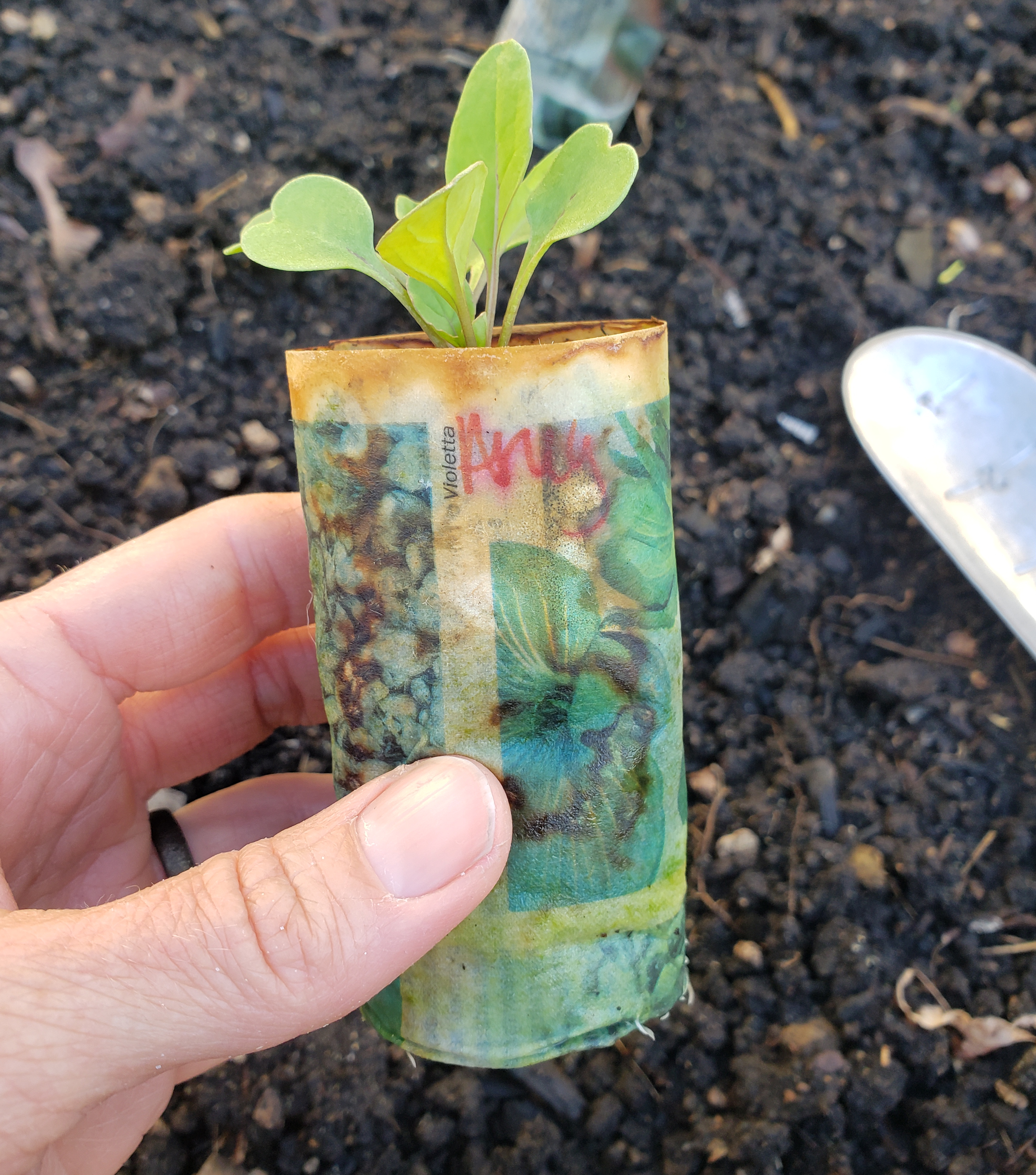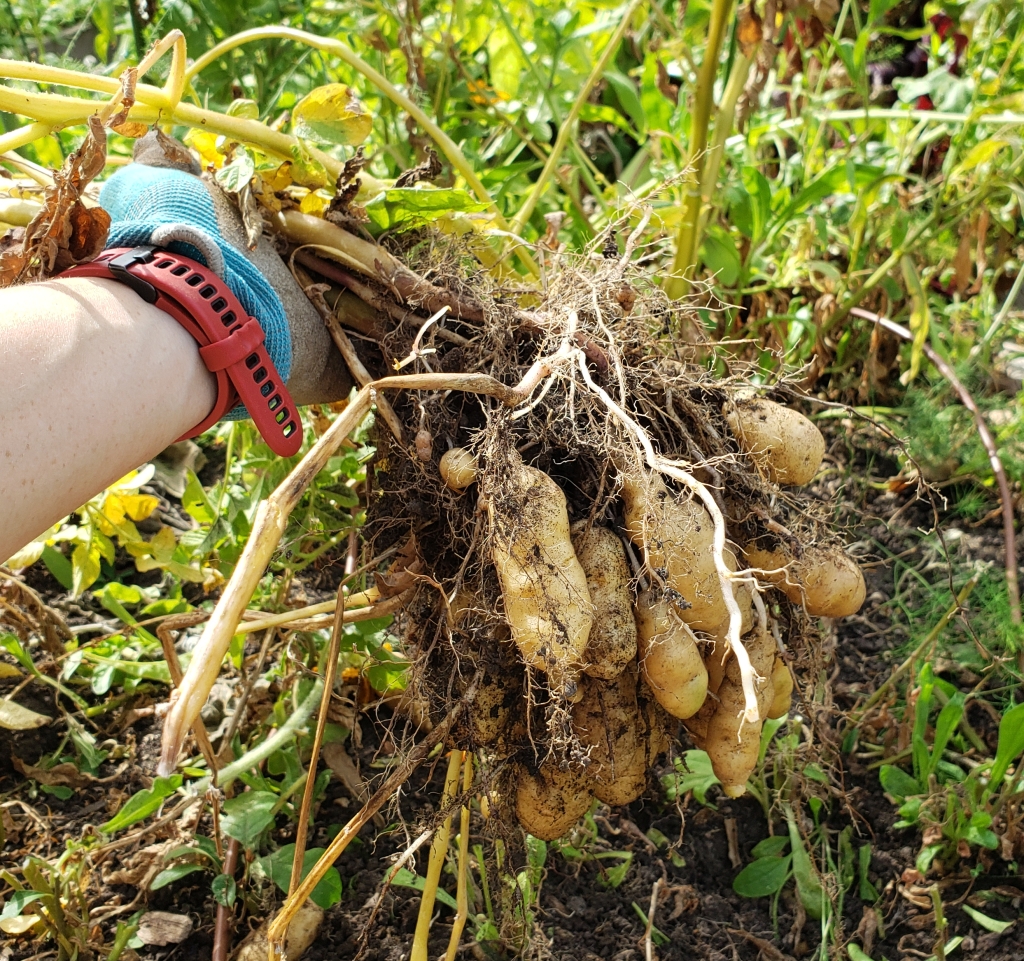Willamette Valley, Oregon, USDA Zone 8b
It’s really starting to cook.🌞 Take that slugs!🐌Yeah.
This is the time when my manicured garden becomes a wild jungle of foliage and flowers.🌼I kinda love it, though. All the insects floating around, spots of color, and the scent of the herbs on a warm evening.
July is growth-season for heat lovers, bolting season for cool weather crops, and harvest season for garlic and many other root crops. It is also time to plan for fall crops and perhaps even start some seeds. Yes! Let’s do this.

July final harvest typically includes:
- Peas
- Garlic
- Spinach
- Salad greens 😭
- Radishes
- Broccoli and most other brassicas.
- Potatoes (toward the end of month)
Bolting and going-to-flower means food for the pollinators and later free seeds for you and the birds.🐦 Consider leaving one or two of each variety and watch the full life cycle first hand. There are always a few awesome surprises in store. (A maybe a few volunteers!)
Fall Garden Planning
Direct Sow
If the space isn’t needed by your zucchini, try sowing seeds from this list. For best results soak the seeds for a couple hours in water and keep the soil moist until they germinate and get established.
- Beets
- Carrots (These need consistently moist soil. Some people cover the seedbed with damp cardboard and checking daily for signs of sprouting and pests.)
- Onion (an overwintering variety)
- Garlic (No rush. I sow garlic as late as November.)
Start In Pots

If you don’t have the space in your garden, wait to sow the garlic and start these seeds in pots toward the end of this month:
- Beets (Prefer direct sowing, but I have transplanted with success.)
- Broccoli
- Cabbage
- Cilantro
- Kale
- Lettuces
- Onions (many overwintering varieties will ripen for an early spring harvest.)
- Spinach
- Swiss Chard
Water Wise Tips

Watering is going to be a big deal now until late September. Willamette Valley averages about a ½ inch of rain this month. Keep an eye on your Weekly Watering Number and read Six Ways to Water your Garden for more tips.
Mulch Your Garden Beds

Now that the slugs are underground for the season, (more or less) it’s OK to add mulch to your veggie garden beds. If you use drip irrigation, drop mulch on top of your lines to retain more water.
- Straw (Verify that it’s untreated. Herbicide residues can harm your plants.) This is my favorite because water goes straight through, it does not inhibit gas exchange, and yet manages to help keep the soil moist. I do get a few sprouts from errant seeds. I just pull and drop.
- Leaf Mold: Fully composted leaves make wonderful mulch. It is nutrient rich and holds a ton of water.
- Compost – a thin layer of compost can help retain moisture and add nutrients.
- More about mulch and green manures
Harvesting
Berry Harvesting Tips

- Pick a couple times a week. I try to get them before they are fully ripe as they last longer after picking and I beat the pests to them. Very ripe berries need to be used or frozen on the same day.
- Remove overripe or rotten berries. Fermenting fruit attracts fruit flies and other nuisance pests. When I’m picking I bring two buckets, so I can take the good berries and rotten ones all in one go.
- Tray freeze. Spread out berries on a tray and freeze for 15 minutes or so, then store in a freezer bag. Tray freezing allows you to pour the berries out of the bag as you need them.
- Pests:
- Stinkbugs like to drain a berry one node at a time. If you’re seeing a lot of these guys, knocking them into a bucket of soapy water is effective. They are also a favorite snack of predators like birds, spiders, and parasitoid wasp and flies and predatory stinkbugs. Diversity of insects in your landscape means ecological balance.
- Spotted Wing Drosophila: *Que evil villain music.* This fruit fly can be trapped using apple cider vinegar traps hung from your trellis.


🧄 Garlic is typically ready for harvest this month. If your garlic stems have turned yellow and crispy, stop watering for a few days or a week, then lift them with a digging fork or trowel. Check out my Garlic Growing Guide for more harvesting tips.
🥔 Potatoes may be ready for harvest by the end of this month depending on the weather and when they were planted. Like garlic, you’ll know when the tops die back. When this happens stop watering and allow them to cure in the soil for a week or so before lifting with a digging fork or shovel. If you have loose soil, you may be able to pull them up by hand. Check out my Potato Growing Guide for more harvesting and storage tips.
🧅Onions are usually ready when the bulbs are of a good size and the tops fall over. They can be lifted from the soil with a trowel and cured in a cool, dark place.
🌿 Herbs. Basil and other warmth loving herbs should start giving this month. Most can be trimmed with reckless abandon and they will grow vigorously and bushy in gratitude.
🍎 Apple Thinning & Pest Control
Thin apples to one per spur. I will leave a couple per spur in the May-June thinning to mitigate future pest damage. Remove any apples that are damaged enough to rot. Rotten apples attract pests and divert energy from undamaged apples. Check-in with your apple IPM and make sure you’re on track. We likely have another codling moth life cycle to weather.
Lawn Care
- The next fertilizer application is due around the 4th of July. Read more in the Turfgrass Growing Guide.
- Water is going to be your primary concern for the next few months. Irrigate early in the morning. Check your weekly watering number on the regionalh2o.org website. Read Six Ways to Water Your Garden & Landscape for more tips.
- Cut on a high setting so it is at least 3″ tall after mowing. Taller grass keeps the soil cool and moist, shades out weed seeds, and promotes deeper rooting to bring up water and nutrients.
- Use the mulch setting. Lawn clippings break down fast and recirculate nitrogen into your soil reducing the need to do more fertilizer applications.
- If you are re-seeding or have seedling grass, water multiple times a day during hot-dry spells. The root system for seedling grass is very tender and shallow and needs consistent moisture until it is established.
- Want more tips for growing grass that is green in all senses of the word? Check out the Turfgrass Growing Guide.
Wildlife Care


Water: A birdbath is a great way to support or feathered and flying insects during our drought like summers. Replace water once a day to keep it cool and minimize possibilities of toxic algae or diseases growing in the stagnant water.
Remove suet feeders during the heat of the summer. There should be plenty of forage, if you want a break from maintaining feeders.
Hummingbird Feeders: Replace nectar and clean feeders at least twice a week. Nectar ferments quickly in the summer heat. If that seems like too much work, remove them until fall. Don’t worry about your little friends. There should be plenty of forage available. I see them picking at spider webs, berries, and sipping on flower nectar. They especially love nasturtiums and fuchsia.
Window strike stickers are a great way to illuminate windows so your bird friends can see them.
Further Reading
- OSU Extension (PDF) Managing Diseases and Insects in Home Orchards
- OSU Extension Service – Monitoring Techniques for Spotted Winged Drosophila
- UC IPM Stinkbugs

